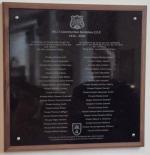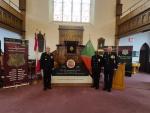Article by Lt Sarah Boehmer, 4 ESR Construction Troop Commander
On 5 July 2025, the 32nd annually held No. 2 Construction Battalion Remembrance Ceremony was held in Pictou, Nova Scotia. The ceremony, organized by the Black Cultural Centre for Nova Scotia, and greatly supported by 4 Engineer Support Regiment (4 ESR), is an annual tribute reflecting the commitment to preserving the memory of the only all-Black battalion in Canada’s military history.
The No. 2 Construction Battalion was formed on 5 July 1916, in Pictou (moving soon after to Truro, NS) in response to the pressing need for labour units during the First World War. Despite systemic racial barriers that prevented Black volunteers from enlisting in combat roles, more than 600 men from across Canada, the United States, and the British West Indies joined the Battalion. They were tasked with constructing roads, digging trenches, repairing railways, and handling timber operations near the front lines in France – often under hazardous conditions. After the Armistice, the unit returned to Canada and was disbanded in 1920, leaving behind a legacy of resilience and quiet heroism that went largely unrecognized until decades later.
This year’s parade featured a uniformed contingents from 4 ESR, local Army/Air/Sea Cadets, Royal Canadian Mounted Police officers, a Highland band, and Canadian Armed Forces veterans. The march covered roughly half a kilometre, tracing the road adjacent to Pictou Wharf before culminating at the steps of St. Andrew’s Presbyterian Church. Among the dignitaries in attendance were His Honour Mike Savage, Lieutenant Governor of Nova Scotia; Lieutenant General Prévost, Chief Professional Conduct and Culture; and Brigadier General Parsons, Commander of 5 Canadian Division. Their presence underscored the significance of the event and reinforced the CAF’s ongoing commitment to diversity and inclusion. Several descendants of No. 2 Construction Battalion members stood proudly in the congregation, bridging past and present and personalizing a history that shaped their families.
After the parade was formally dismissed on the church steps, participants filed inside for the Remembrance Ceremony. Members observed a moment of silence, followed by the solemn laying of commemorative wreaths. The atmosphere was reverent yet hopeful, as attendees reflected on the Battalion’s contributions and the broader lessons of history.
In a gesture of remembrance, LCol Summerfield, CO 4 ESR, unveiled a commemorative plaque, supported by a donation from the Canadian Military Engineers Association (CMEA). Engraved with the names of every Battalion member who died in service, the memorial was presented to St. Andrew’s Presbyterian Church, the ceremony’s annual venue. Now permanently displayed in the church, the plaque serves as a tangible reminder of sacrifice for congregants, visitors, and community members alike.
Speeches by CAF leaders and community representatives echoed a powerful keynote theme: the perseverance of No. 2 Construction Battalion members in the face of persistent discrimination and the imperative for continued institutional and societal change. Speakers challenged today’s generations to honor that legacy not only with words but through concrete strides toward equity within the CAF and across Canada.
4 ESR expressed heartfelt thanks to the Canadian Military Engineers Association for their steadfast support in making the plaque possible. The event stood as a living affirmation of resilience, unity, and progress, ensuring that the story of the No. 2 Construction Battalion endures and continues to inspire a more inclusive future.
Picture 1. The No. 2 Construction Battalion commemorative plaque presented by CO 4 ESR, LCol Summerfield, with the support of the CMEA, to the St. Andrew’s Presbyterian Church.
Picture 3. LCol Summerfield (CO 4 ESR), CWO Gilbert (RSM 4 ESR) and Lt(N) Gonese (4 ESR Chaplain) at the No. 2 Construction Battalion Remembrance Ceremony.

